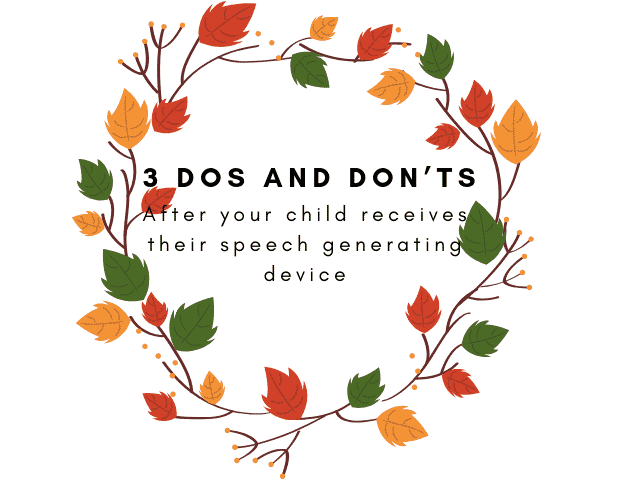
First, your child completed trials of Augmentative and Alternative Communication techniques with your Speech-language Pathologist. Then, an AAC evaluation was performed. This was followed by the device request process. Now, your child has a speech generating device (SGD). What are the next steps?
DO Bring the SGD to Therapy Session, DON’T Leave it at Home
Speech-language therapy should always focus on functional communication skills. If your child obtains a device, it is likely that their current method of communication is not sufficient for them. This means that they are not able to communicate to their full potential when they don’t have their SGD! Speech-language therapy will focus on device training to both caregivers and the individual user. Device training may include personalization like having an “about me” page where they can share their name, age, and birth date. In addition, speech-language therapy focuses on development including language expansion like using two words to request (“Want ball”). AAC users are encouraged to bring their device to other therapy services like occupational therapy. Our occupational therapists work closely with their treating speech-language pathologists to learn how to support SGD use as well.
DO use the SGD at Home, Social Settings, School, DON’T only use it in Therapy
People communicate in many different environments throughout the day! Children using augmentative and alternative means to communicate need to be able to do the same. SGD users should be able to introduce themselves to unfamiliar communication partners, order food at a restaurant and answer questions in class. This not only gives them a voice in their natural environment but it is rewarding for individuals to see the power of communication outside of the treatment room. Devices can be heavy, large and bulky. This is a very important consideration to think about during the trial process. The device should fit you and your child’s lifestyle. There are many options for carrying cases, straps, packs and mounts that should be considered when choosing a device for your child.
DO Incorporate the SGD with Fun and Functional Activities, DON’T Drill
Drill practice is often used in other areas of speech-language pathology, like articulation. Drill practice for AAC use, like having a child indicate “eat” over and over again to teach them where the word “eat” is located is likely not going to be enjoyable for either parties. Motivation is key! It is so important to incorporate SGD use in fun and entertaining activities. Families can incorporate AAC into any fun activity that your child already enjoys. Parents can use aided language stimulation strategies in activities as simple as reading books or eating lunch. This video shows a mother and son making slime. The mother models comments “uh-oh”, requests “help” and narration “in” while playing. Notice she is just modeling using the device and not cuing her child to also use the device. This is a great example of a language rich environment that is using the child’s language, the AAC system.
Conclusion:
Now that your child has received their speech-generating device (SGD), consistent use across environments is essential to support communication growth. Remember: bring the device to all therapy sessions—including Occupational Therapy Services, where our occupational therapists collaborate with speech-language pathologists to support AAC use. This includes both pediatric occupational therapy and occupational therapy for adults, depending on your child’s needs.
Outside of therapy, encourage your child to use their SGD at home, in school, and in social settings. Integrating the device into everyday routines and play—rather than relying on repetitive drills—fosters motivation and engagement. Activities that are fun and functional make learning natural and enjoyable. You can also support your child’s growth by engaging in Social Skills Group sessions, where they can practice communication with peers in structured, supportive environments.
For holistic support, consider additional services like Counseling Services, which can help families and individuals navigate the emotional journey of adapting to AAC and fostering communication. Together, these services build a strong foundation for your child to thrive as a confident communicator. Contact us now!

Yours in Health,
New Horizons Wellness Services13333 SW 68th Pkwy,
Tigard, OR 97223
- https://g.page/newhws
New Horizons Wellness Services provides a true multidisciplinary approach to mental & physical health treatments for children, adults and families.